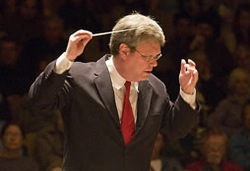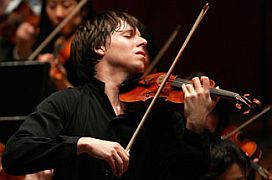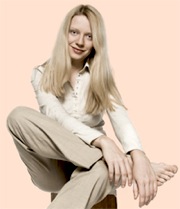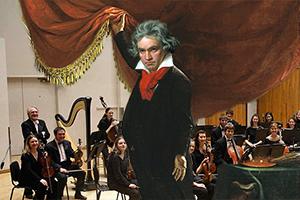Symphony concerts are good places to bring friends. There’s excitement, variety, time to talk at intermission, a focal point to the evening, and a chance to do something together afterward. The fall season in the Bay Area is crammed with goodies everyone can love. There’s no better time to bring a wary companion to one or more of the following concerts, guaranteed to appeal to old hands and neophytes alike. Each stands out in its own category, presumptuously awarded by yours truly.
Best Bargain: University Symphony Plays Tchaikovsky

This deal’s so good you’ll have no trouble convincing friends to go with you: one of the most popular of all symphonies, in one of the most comfortable and acoustically satisfying halls in the Bay Area, for only $15 ($10 for seniors and non-UC Berkeley students). We’re talking Tchaikovsky’s Fifth Symphony in UC Berkeley’s Hertz Hall. (See if your guest can say what song standard came from the theme to the second movement, recorded by Frank Sinatra, Glenn Miller, Harry James, and Chet Baker.) The orchestra plays very well, but at this price, what’s to worry? [Trivia answer: Moon Love]
David Milnes conducts the UC Berkeley Symphony Sept. 24, 8 p.m., Hertz Hall $15/ $10 (seniors, non-UC Berkeley students)
Best Themed Concert: Symphony Silicon Valley, Gypsy Airs
Too often, marketers pull out a “theme” for a concert that does little or nothing to characterize its music as a whole. Symphony Silicon Valley got most of it right for Budapest-born conductor Gregory Vajda’s survey of Hungarian music, which they named after Pablo Sarasate’s Zigeunerweisen. Of course, this slights a gorgeous Hungarian work on the program unrelated to folk elements, Erno Dohnanyi’s Symphonic Minutes, and implies all folk sources in Hungary are of Romani origin. But any newcomer to orchestral music will be rewarded with, in addition to the Sarasate, three Hungarian Rhapsodies by Brahms; Béla Bartók’s Hungarian Sketches; Maurice Ravel’s violinomaniacal Tzigane; and Zoltán Kodály’s Dances of Marosszek.
Gregory Vajda conducts Symphony Silicon Valley, Oct. 16, 8 p.m., and Oct. 17, 3 p.m., California Theatre, San José, $39-$75.

Best First-Timer Concert: Joshua Bell and the San Francisco Symphony
This is a fine program that should appeal to people who shy away from orchestral concerts. The “Indiana Living Legend” and busker-in-a-subway Joshua Bell will be playing Max Bruch’s Violin Concerto No. 1. And, for advocates of recycling, there are three late-Dvořák overtures, each of which is based on the same melody: Carnival, Othello, and In Nature’s Realm. Wagner’s Prelude to Die Meistersinger von Nürnberg begins the festivities.
James Conlon conducts the San Francisco Symphony Oct. 21-23, 8 p.m., and Oct. 24, 2 p.m., Davies Symphony Hall, S.F. $15-$150.
Best Youth Orchestra Concert: San Francisco Conservatory Orchestra, with students from the Sydney Conservatorium
Hands across the sea and all that. The San Francisco Conservatory continues to forge relationships with countries along the Pacific Rim, and this time the fine Conservatory orchestra shares the stage with Australian friends. Their joint concert has at least one guaranteed winner for the casual listener: Mussorgsky’s Pictures at an Exhibition in Ravel’s opulent (and challenging) orchestration. Also on the program is Barber’s gorgeous and nostalgic orchestral song about a family afternoon, Knoxville, Summer of 1915.
Andrew Mogrelia conducts the Conservatory Orchestra, Oct. 22, 8 p.m., Concert Hall, S.F. Conservatory, $20/$15 (students and seniors).
Most Extroverted Program: Santa Rosa Symphony, Classical Two

This amped-up tour of Eastern European composers, courtesy of the Santa Rosa Symphony, opens with George Enescu’s glorious chain of Danube melodies, the Romanian Rhapsody No. 1, notable for one of the most insinuating waltzes ever written. Next come two concerto extravaganzas, the Piano Concerto No. 1 and Totentanz by Hungarian Franz Liszt, played by the Ukrainian virtuoso (and beauty) Valentina Lisitsa. Totentanz is a set of variations on the Medieval chant Dies irae ("Day of Wrath"), which has obsessed so many composers. After intermission comes comes Béla Bartók’s Concerto for Orchestra, in almost everyone’s top 10 list of the greatest and most accessible 20th-century works, and famous for its whirlwind finale.
Bruno Ferrandis conducts the Santa Rosa Symphony, Nov. 6 and 8, 8 p.m.; and Nov. 7, 3 p.m.; Wells Fargo Center for the Arts, $27-$55.
Most Appealing New Music Program: Berkeley Symphony, Musica de Amor
Here’s something unusual: a concert with two 21st-century works and one less-frequently-performed 20th-century work, all of which should please most of the audience. The evening begins with a yet-unnamed premiere by the Mexican composer Enrico Chapela, whose music describing a soccer match (Inguesu) entertained listeners last year at the Cabrillo Festival in Santa Cruz. His jazz-folk-classical-fusion style can be sampled online. Those who missed Peter Lieberson’s romantic and touching Neruda Songs, which I previewed earlier this summer for the Festival del Sole, will have a chance to hear it sung by the young, Juilliard-trained mezzo-soprano Rachel Calloway. She will also lend her voice, which one critic described as “sumptuous,” to sultry lines in the El Amor Brujo (Love, the magician) suite by the Spanish composer Manuel de Falla.
Joana Carneiro conducts the Berkeley Symphony Dec. 2, 8 p.m., Zellerbach Hall, UC Berkeley.
Honorable Mentions
The Marin Symphony offers an attractive program in November. Along with Tchaikovsky’s Fourth Symphony, you’ll hear a premiere by in-demand Israeli composer Avnar Dorman, plus William Walton’s urbane and melodic Viola Concerto.
The California Symphony ties in to the Bedford Gallery’s exhibition of New Deal art in Walnut Creek’s Lesher Center for the Arts. The Oct. 3 concert will feature music from the WPA’s Federal Music Project, as recently described in SFCV’s Music News.
Two choral concerts present pleasing, unusual fare: the San Francisco Symphony’s performance of John Adams’ El Niño (Dec. 2-4), and the Peninsula Symphony’s performance (Nov. 19-20) at Stanford University of Ralph Vaughan Williams’ Hodie.
Finally, if you can persuade someone to ride with you to the Santa Cruz Symphony on Oct. 2 or 3, you can both hear two of the most popular works in the repertory, Holst’s Planets and Gershwin’s Rhapsody in Blue. That concert begins with the relatively rarely heard Batuque by one-hit-wonder Oscar Lorenzo Fernández, a number guaranteed to get hearts pumping and bodies twitching.

